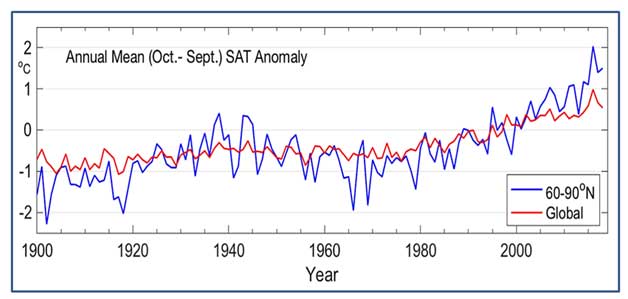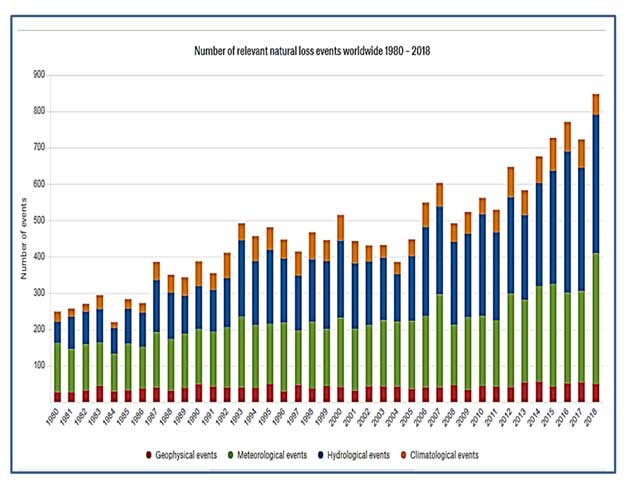Since its inception the Paris climate accord has been in questiondue to,among other(1) its broad definition, intended to keep a mean global temperature rise this century to below 1.5oC and efforts to limit temperature increase well below 2oC above pre-industrial levels; (2) its non-binding nature; accounting tricks by vested interests. The goal assumes pre-determined limits can be placed on greenhouse gas levels and temperatures beyond which they would not continue to rise. Unfortunately these targets do not appear to take account of the amplifying positive feedback effects from land and oceans under the high cumulative greenhouse gas levels and their warming effects. Thus unfortunately the current high CO2 levels of about 408 ppm and near-500 ppm CO2-equivalent (CO2+methane+nitrous oxide) would likely continue to push temperatures upwards.
Significant climate science evidence appears to have been left out of the equation. The accord hinges on the need to reduce emissions, which is essential, but it does not indicate how further temperature rise can be avoided under the conditions of a high-CO2 atmosphere, which triggers carbon release, unless efforts at sequestration (down-draw) of greenhouse gases are undertaken. Inherent in global warming are amplifying positive feedbacks, including albedo (reflection) decline due to the melting of ice and the opening of dark water surfaces, increased water vapor contents of the atmosphere in tropical regions which enhances the greenhouse effect, reduced sequestration of CO2 by the warming oceans, desication of vegetation, fires, release of methane from permafrost and other processes. This means that even abrupt reductions in emissions may not be sufficient to stem global warming, unless accompanied by sequestration of greenhouse gases from the atmosphere to a lower level, recommended as below 350 ppm CO2by James Hansen, the leading climate scientist.
The world is on track to produce 50 percent more fossil fuels than can be burned before reaching the limit prescribed by the Paris agreement, with currently planned coal, oil and gas outputs making the Paris goal impossible. Projected fossil fuel production in 2030 being more than is consistent with 2°C, and 120% more than that for 1.5°C.
Unbelievably, according to the International Monetary Fund, “In 2017 the world subsidized fossil fuels by $5.2 trillion, equal to roughly 6.5 percent of global GDP”, which is more than the total the world spends on human health. Such subsidies cannot possibly be consistent with the Paris accord. The pledge to end fossil fuel subsidies by 2025 by the G7 nations , with exceptions by the UK and Japan, may come too late as global CO2 concentrations, already intersecting the stability limits of the Greenland and Antarctic ice sheets, are rising at a rate of 2 to 3 ppm per year, the highest in many millions of years.
Despite the scientific consensus regarding the anthropogenic origin of global warming, the world’s biggest fossil fuel corporations are taking a defiant stance against warnings that reserves of coal, oil and gas are already several times larger than can be burned if the world’s governments are to meet their pledge to tackle climate change. ExxonMobil said new reserves in the Arctic and Canadian tar sands must be exploited. Peabody Energy, the world’s largest private coal company, said global warming was “an environmental crisis predicted by flawed computer models”. Glencore Xstrata said that governments would fail to implement measures to cut carbon emissions. The World Bank and Bank of England have already warned of the “serious risk” climate action poses to trillions of dollars of fossil fuel assets.
Not to mention the risks to the living Earth and its billions of inhabitants!
The apparent neglect of scientific advice is not an isolated instance. It is not uncommon that climate reports are dominated by the views of economists, lawyers, bureaucrats and politicians, often overlooking the evidence presented by some of the world’s highest climate science authorities. Whereas the IPCC reports include excellent and comprehensive summaries of the peer-reviewed literature, the summaries for policy makers only partly represent the evidence and views of scientific authorities in the field, including those who have identified global warming in the first place.

Fig. 1. Arctic (land stations north of 60° N) and global mean annual land surface air temperature (SAT) anomalies (in °C) for the period 1900-2018 relative to the 1981-2010 mean value. Source: CRUTEM4 dataset.
There exists a tendency in the media to report averages, such as average global temperature values, rather than the increasingly common anomalies. For example, the annual mean global temperature rise of +0.8 degrees Celsius for 2018 is about one third the Arctic mean temperature rise of up to +3 degrees Celsius (Fig. 1). Given that developments in the Arctic bear major consequences for global warming. Given that developments in the Arctic bear major consequences for climate change, the global mean of +0.8C does not represent the seriousness of the climate crisis.
Another example is the way extremes weather events are reported as isolated instances, neglecting the rising frequency and intensity of hurricanes, storms, fires and droughts, indicated in frequency plots (Fig 2).

Fig. 2.Number of relevant natural loss events worldwide 1980–2018. Munich-Re.
It is not until international and national institutions take full account of that climate science is indicating that a true picture of the climate crisis will be communicated to the public.
Andrew Glikson, Earth and climate scientist
SIGN UP FOR COUNTERCURRENTS DAILY NEWS LETTER









































